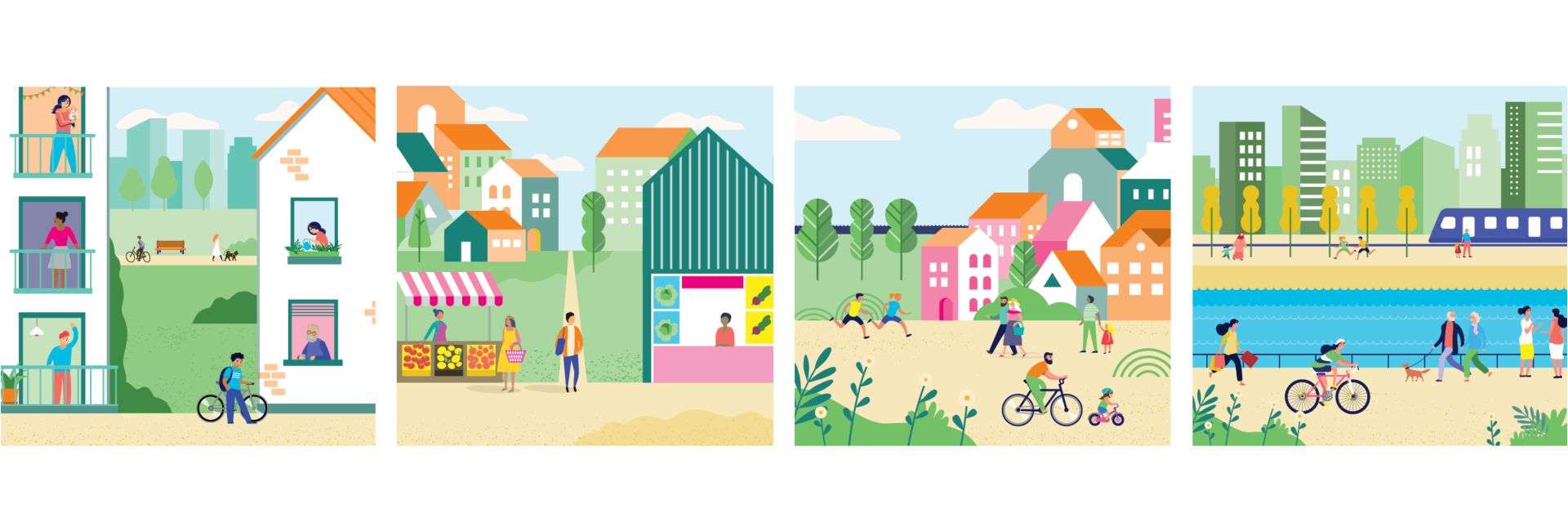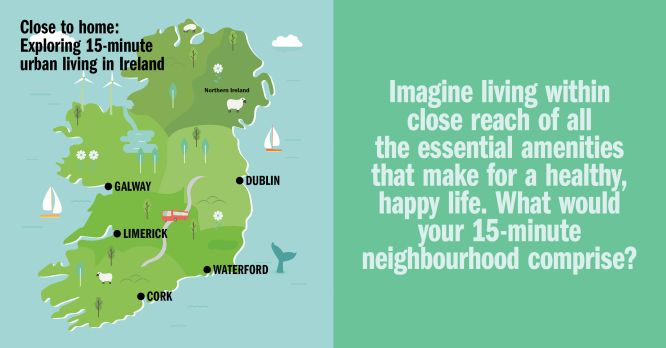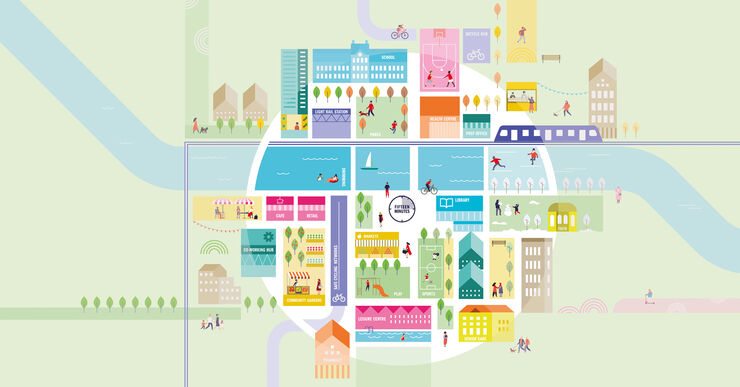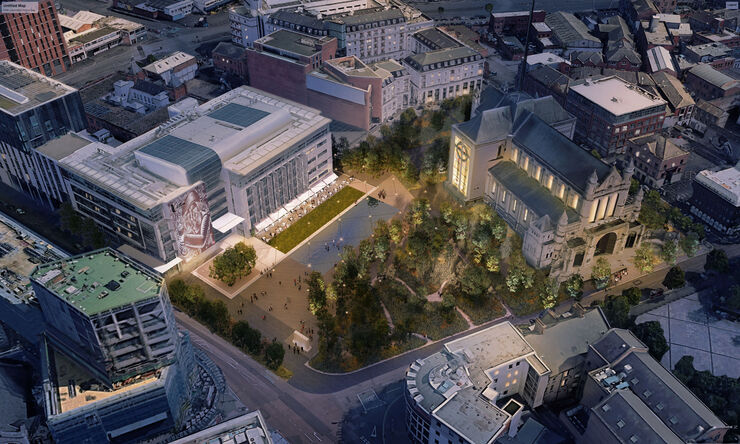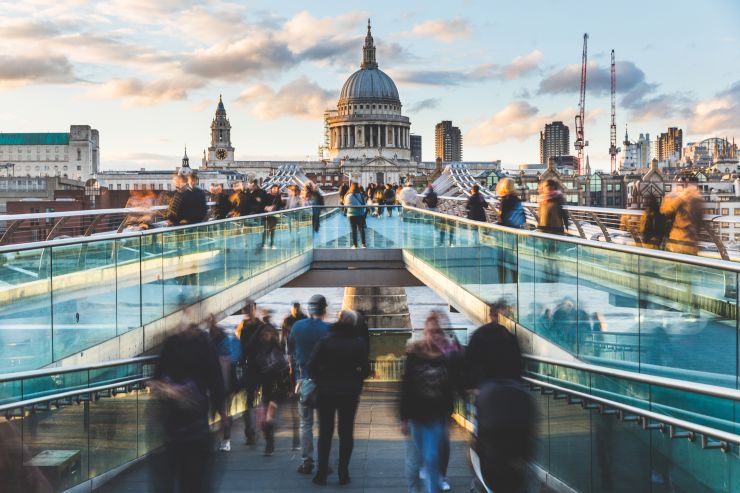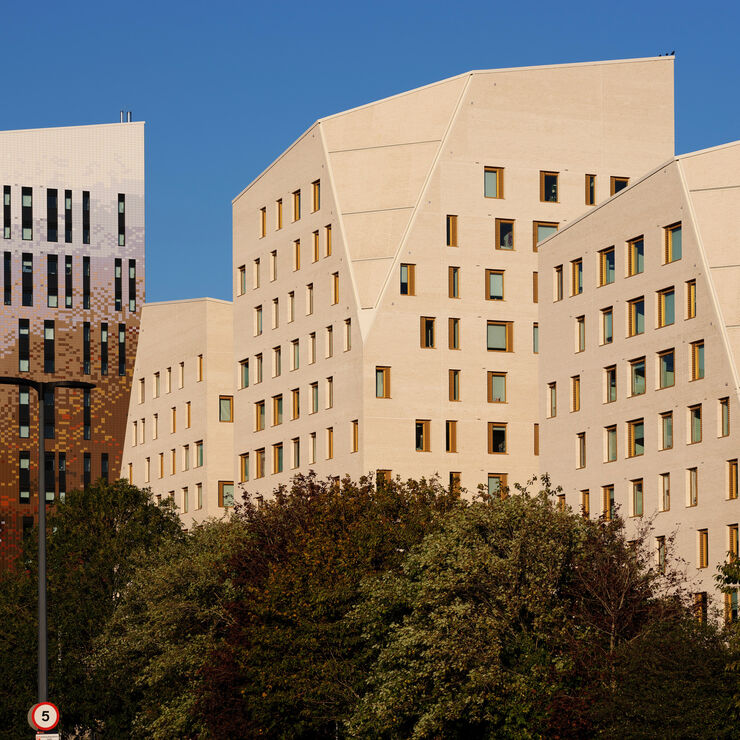Transcript
Camilla Siggaard Andersen:
From Hassell, an award-winning architecture and design practice, this is Hassell Talks.
Camilla Siggaard Andersen. I’m an architect, and I’ve always been really interested in understanding how design shapes social, environmental, and economic outcomes in our cities and communities. And the more I’ve looked into it, the more certain I am that the built environment is the cause of and the solution to many of the issues we face as individuals and as a global society. In fact, there are enormous amounts of research to show that almost everything about our health and well-being, from how we feel when we look out of our bedroom window in the morning to the quality of the air we breathe when we travel to work, can be related to the design of the spaces, buildings, and transport networks that we use. Still, it’s rare for urban planning research in theory to make it into the public discourse, until now.
Brian Moran:
Ireland, and indeed the main cities in Ireland, are going through a significant challenge.
Camilla Siggaard Andersen:
That’s Brian Moran, senior managing director at Hines Real Estate in Ireland.
Brian Moran:
It’s fantastic to see the concept of the 15-minute city become more and more prevalent, becoming something that is getting into the common discourse here in Ireland. And it’s recently become more relevant here as the city plans are being renewed, and we were very happy to see how did that concept apply in Ireland.
Camilla Siggaard Andersen:
As a developer, Brian is naturally interested in the planning of cities and places. But the concept he’s talking about, the idea of creating a 15-minute city, has captured people’s attention far beyond the usual industry professionals. Last year in February 2021, Dublin City Council published survey finding that just over one in three of the city’s residents knew and understood this concept. The year before, in 2020, the mayor of Paris, Anne Hidalgo, was reelected with the 15-minute city as the cornerstone of the campaign focused on improving the quality of life for everyday Parisians. In Melbourne, Australia, the notion of a 20-minute neighbourhood has been shaping planning decisions since 2018. And in Portland, USA, the idea has been one of the city’s core consultation tools since 2006.
The 15-minute city, 20-minute neighbourhood, or indeed in some places, 10-minute towns, are all variations of the same essential idea, and that is that the built environment should be planned to increase people’s access to everyday places and services.
What amenities do people have access to close to home, and how easily can you get to them? That’s a central question that all of these concepts beg us to ask. In this episode, we’ll be talking about 15-minute cities on the basis of a comprehensive research study Hassell published last year together with Irish institutional Property. We’ll be taking a closer look at the future that this concept could unlock for Ireland, the Irish cities, and their citizens.
Pat Farrell:
My name is Pat Farrell. I’m CEO of Irish Institutional Property. IIP is a membership of 17 institutional investors. Collectively, they’re responsible for upwards of 16 billion of investment in the Irish real estate market. And that investment is focused a lot of it on housing built for purchase, and indeed, housing for rent because we have a chronic housing shortage in Ireland, both for rental and for ownership.
Camilla Siggaard Andersen:
As an organisation with their finger in the pulse in the local real estate market, Irish Institutional Property came to us with a keen interest in understanding how such an idea as the 15-minute city could be applied in five Irish cities.
Pat Farrell:
The five Irish cities we focused on, and there are five effective population centres in Ireland that qualify as I suppose in those terms as cities, Dublin, Cork, Waterford, Limerick, and Galway. They’re all endowed with very rich natural amenities because we’re an island nation, and all of our cities are located on the coast. So they have huge access to both green and blue infrastructure.
Historically, Irish cities in the 18th century were built with walkability in mind. So all of our cities actually, you could access all of the key amenities within 15 minutes. So you could say that Irish cities were ahead of their time. They were actually 15-minute cities in reality, but then of course the onward march of suburbanization meant that that concept got lost somewhat. And so I suppose the current challenge is to try and reclaim that feature.
Camilla Siggaard Andersen:
In addition to being a compelling narrative for an urban revival, the idea of 15-minute city also happens to be closely aligned to the Irish government’s national planning agenda, something Pat’s keenly aware of.
Pat Farrell:
In the Irish context, the government has actually officially mandated compact growth as part of its National Development Plan and its strategy for developing our cities and towns.
Camilla Siggaard Andersen:
Pat’s talking about Ireland’s National Planning Framework, also known as Project 2040. It’s essentially a strategy for how to manage the nation’s expected population boom in the most sustainable and responsible manner, all the while addressing latent issues and mounting pressures on the housing market, public transport, and shared amenities. Key objectives include preserving the natural environment by curbing suburban sprawl, increasing the quality of life for people by providing more and better amenities, reducing the nation’s carbon emissions per capita by reducing car dependency, and creating a stronger economy based in local skills and innovation. The government has called this a vision of compact sustainable growth, but in many ways it might as well be speaking of the 15-minute city.
Niamh Moore Cherry:
My name is Niamh Moore Cherry and I am a lecturer at the School of Geography at University College Dublin. And I was a local consultant with Hassell on this 15-minute cities project.
Camilla Siggaard Andersen:
With both the 15-minute city concept and the National Planning Framework, talking about bringing people closer together to create more sustainable and amenity-rich local environments, we look to Niamh to understand how this vision fits in with where Ireland’s currently at.
Niamh Moore Cherry:
Well, Ireland has a really ambitious programme at the moment in terms of what we want our future to look like. So in February 2018, the government published the National Planning Framework, which I would argue is actually one of the most ambitious planning frameworks of any country in the world.
The issue now is about implementation. There’s a range of historical and economic reasons why there’s a challenge to density in Ireland, and partly it’s because of the history of development and how Dublin expanded and many of the other cities expanded. There’s no real history of industrialization in the city course, so when the city’s expanded over time, they expanded on the edge. So suburbanization has resulted in massive sprawl, lots of employment is on the edge of the city. And that really then creates a challenge in terms of where people live, trying to access where they live from where they’re employed, and that also creates big problems then in terms of trying to move people around the city and the dependence on cars and so on. So what we have is a disconnect between where employment is located and where housing is located, which gives rise to the challenges that we see.
Camilla Siggaard Andersen:
Pat Farrell also talks about the current issues of sprawl and car dependency in Ireland.
Pat Farrell:
Somebody I was speaking to earlier this morning mentioned the fact that Dublin has 10 drive time radio stations. So that tells you something about what is the primary mode of transport for getting in and out of Dublin.
Camilla Siggaard Andersen:
The average daily commute in Dublin is almost one hour, making it one of the longest travel times of any European capital.
Pat Farrell:
We don’t have a well-developed public transport infrastructure. And again, there’s a very strong linkage between that and the way our city has evolved. The economics of public transport in Dublin are very difficult because we’re a very low rise city, and therefore you’re putting in place a transport infrastructure to pull through a very thinly populated urban centre. And therefore, that presents a lot of challenges. Compact growth, 15-minute cities, and everything that goes with that is the answer. But again, as our report shows, there are lots of challenges in trying to bring people along with that conversation and get them to accept the trade-offs that are necessary to achieve what we think is a very laudable ambition.
Camilla Siggaard Andersen:
As both Pat and Niamh point out, Ireland’s century-long preference for low rise, car-centric development has created serious barriers for realising today’s 15-minute city vision. In studying the population densities of the five Irish cities, we discovered that in Dublin, only two in five people live in an area with enough residents to be able to feasibly meet the 15-minute city criteria. While for the four other cities, it’s only 1 in 10. Incidentally, most of these areas predate the 20th century when walking was still the primary mode of transportation.
These numbers also mirror the results of a population survey Hassell conducted via YouGov. The survey reached more than 1,000 Irish adults. By asking people about their current access levels, we learned that only 10% of the Irish population currently feel that they can walk to all the essential amenities within 15 minutes or less. Reflecting Niamh’s observations, workplaces tend to be the least accessible amenity, while grocery shops and public transport stops are in higher supply. When asked about the ideal situation, 1 in 3 people would like to be within a 15-minute walking radius of every single type of amenity that we listed. While 33% may not sound like a landslide victory for the 15-minute city concept, it still triple the number of today’s situation and an impressive result considering that some people might not have any interest in accessing, for example, workplaces or educational institutions, or some people are also limited in their ability to walk altogether.
Niamh Moore Cherry:
The quality of life for people living in cities in Ireland is quite variable. For example, in Dublin, many people can’t afford to live close to their employment, so they’re commuting very long distances, and it means their quality of life is really negatively impacted by that. Whereas if you look at some of the smaller cities, for example, Waterford, where there’s an opportunity and where there are more people living close to home, you see that there is less of a negative impact. But also the natural amenities. If we think of Cork Harbour for example, the natural amenities around Cork are really playing into much better quality of life livability and experience for people living closer to the city centre.
So I think it really depends on the city in Ireland, and it’s really down to how close you are to your employment, to your amenities, to natural amenities, to your shops, to your grocery stores, and so on. So the greater distances you have to travel for those things, the lower quality of life, if you like. They’re less livable places.
Camilla Siggaard Andersen:
At this point, you might be wondering why we keep talking about issues of transport and density when the 15-minute city is supposed to be about gaining access to a greater variety of amenities within a local neighbourhood.
Just for those of you out there who are new to urban planning, here’s the short version of how these factors are related. Imagine living in a place where you have five to six different destinations close by, such as a park, a grocery shop, a library, a café, a dentist, and maybe a nursery. Let’s say that you’d like to be able to walk to each of these destinations within a quarter of an hour, and that you walk at an average speed of five kilometres per hour. In effect, each destination would have to be within a 1.25-kilometre radius from your home.
Each of these places in turn need visitors and customers, other people who are able to reach them by foot as part of their daily comings and goings. In order for most businesses to survive, they need quite a few visitors every day. Even a library needs a minimum footfall just as a school needs pupils. If there’s not enough people within a walking distance, then a destination essentially has two choices. It can either close up shop or it can try to attract people who are coming from further away, such as by car. And that might be all right, except now you have more traffic on the roads and you have more areas for parking, which makes the environment less conducive to walking and takes away space that could have been used for homes or parks or other types of amenities.
Global studies find that a population density of between 5,000 to 25,000 people per square kilometre or 50 to 250 people per hectare is ideal for making sure that there are enough people around to sustain the local economy and the local amenities within a primarily walkable environment. These are the types of densities that we find in places like Central Copenhagen and Vienna and Paris. Additionally, these types of places benefit from being able to operate more sustainably with a lower carbon footprint per capita.
Niamh Moore Cherry:
Our cities are fundamentally sustainable if they’re built properly. There is a sense out there that cities are highly unsustainable because there’s lots of people there. There’s buildings emitting energy and so on. But actually, cities are where the solution to the climate crisis is going to be found because they provide opportunities because of higher density living, people living closer together, to be able to provide public transport and make it viable to actually give people options other than jumping in a car to get from A to B. So cities, the packing of people close together in quality environments is actually central to addressing some of the issues that emerge from sprawl, from pollution that comes from that, and so on.
Camilla Siggaard Andersen:
At the moment, none of the Irish cities meet the overall density levels required to provide amenities within a 15-minute walk of most people’s homes. There’s simply too much space between people and too many cars on the roads.
Niamh Moore Cherry:
The struggle in Ireland around adopting density, I think, is something that’s gone on for quite a long time, but it’s something that really will have to stop soon.
Camilla Siggaard Andersen:
The government’s compact growth agenda clearly signals a change in the direction of adding more homes where people already are instead of on new sites that expand the footprint of the city. But the actual route to implementation is not just about adjusting numbers, but very much about changing hearts and minds too.
Pat Farrell:
If you’re talking about significant change in urban areas, which is what you are looking at with compact growth, then we need to have early conversations with people about the benefits and the trade-offs as well as the challenges. Now, in Ireland, we’re used to having a lot of space, a front garden, a back garden. With compact growth, we’re not just talking about behavioural change, but there’s also a change in expectations. Ireland hasn’t really experienced large scale quality urban planning of the kind that’s associated with successful 15-minute city strategies. We need to do more work on that, and there are already good examples emerging. I think as people see more and more of those good examples and actually live in them and experience them, then people will buy more and more into the concept.
Camilla Siggaard Andersen:
The question now is are the citizens of Waterford, Galway, Limerick, Cork, and Dublin ready to embrace everything that would be required of them to make the 15-minute city a reality? As Pat and Niamh explained, the chief challenge to the 15-minute city concept in Ireland has to do with attracting more residents to settle within existing urban areas paired with increasing walking, cycling, and public transport use, and providing the supporting amenities.
Brian Moran:
Without that densification of our cities and towns, we will never get to the 15-minute concept that we aspire to. I’ve heard some people say, “Well, you can’t densify because the services aren’t there, that the local GP does not exist, that there is not the amenities to sustain more density in these urban situations.” But that is the chicken and egg conundrum. The reality is as soon as you bring the density, the services will come.
Camilla Siggaard Andersen:
That’s Brian Moran again, the senior managing director in the development group Hines, who are also members of Irish Institutional Property. Private developers like Hines are some of the key players required to meet the goals set out by the government’s National Planning Framework.
Brian Moran:
In recent years, we’ve had significant new guidance that is mandatory from central government requiring developers, especially on larger sites in regeneration, brownfield infill sites to where they have scale to tackle the density challenge and come up with good design that is much higher density than previously would’ve been done in Ireland.
Camilla Siggaard Andersen:
Brian’s also seeing the opportunity to regenerate the Irish cities around a 15-minute city idea as a chance to align social, environmental, and economic ambitions.
Brian Moran:
Even in Dublin City over the next 20 years, we probably have to grow our housing stock by about another 30%. That’s very significant. That cannot happen by urban sprawl. We’ve already stretched the city to as far as we should, and we’ve got to look at the balance being infilled, brownfield development to achieve that. That’s a phenomenal investment opportunity, no question about it. And I think one of the challenges as a small country is we actually have to import a lot of the capital to do that work. Previously, Irish people invested locally. That led to a very big bubble. I think people were aware of the crash in 2008, 2009, where we kept investing in ourselves and driving the prices up. That’s stopped. There’s a lot of regulation around that, but also many Irish investors now diversify globally. So we actually need to bring investment in, and about 80% of the capital we need to build are the residential development going forward and now will have to be imported.
Many international investors in particular, the institutional investors, are only going to invest where there’s a strong ESG focus. They’ve got to know that their investments are going into sustainable development. Building non-sustainable development is not going to be something that their boards will sign off going forward. So we have to have a good debate here around the 15-minute city, sustainability, and creating investment opportunities that match the aspirations of investors.
Camilla Siggaard Andersen:
At the moment, Hines have more than $3.7 billion worth of assets under development in Ireland. As a developer, Brian can clearly see the benefits of the compact growth agenda and the 15-minute city idea, and he’s keen to see both concepts realised over the coming decades. But in working on large scale projects all around the country, he also has a first line view of the barriers holding these projects up.
Brian Moran:
We have a very large site of the South Circular Road, which is if for those people who don’t know Dublin, is on the CBD edge. So you’re talking 10 minutes cycle distance to the big employment hubs, maybe 20 minutes walk so a perfect place to live but not have to use anything other than walking and cycling to get to work. It’s got existing urban villages right beside it. By the way, some of them are struggling because there isn’t the density of people there, but that would benefit from a significant additional population.
We’re under an obligation in terms of meeting national guidelines around density to build so that it’s a compliment to the existing lower densities. We have to have large setbacks so the buildings around the edge of the site which need to respect the existing communities are only two, three stories growing up, step by step, four, five stories. But by the time we get to the centre of the site, which is 100, 150 metres away from any existing housing, we need to be at 15, 16 stories. And therefore, we have to use great architects who are well able to do replace making, understand daylight shadowing, public space to get that right. And we are definitely having a real challenge getting projects like that through the planning system because of the backlash on height. I think if you sit down with people, they’re not arguing about, “Great to have new people, great to have new architecture, let’s get more housing in. Height, we just don’t want height.”
Camilla Siggaard Andersen:
What Brian is coming up against is the negative perception of density and height that prevails in Ireland despite the social, economic, and environmental benefits that such places might bring. There’s also the perception that density has to be delivered alongside tall buildings, which one only has to look to Copenhagen or Paris to see as a fallacy. Here’s Niamh again explaining where people’s apprehension might be coming from.
Niamh Moore Cherry:
For people who aren’t sure about a change in density in their cities, I can completely understand that because we have had a very historical negative, I suppose, reaction to high rise, high density living in Ireland. We have very few good examples. So what I would say is that it’s not necessarily the idea of higher density living that’s the problem, but it’s how it has been done in the past. So what we need to think about is what are the benefits of this higher density living? What can we actually achieve by bringing places closer together? And what are the benefits for having everything in close location, time savings, better air quality, better access to amenities, and generally just a better quality of life.
Other cities in Europe have evolved in a similar way, but I think the core difference between Ireland and those other places is first of all, we have a very different historical background. So I think Ireland has this very rural, traditional, agrarian kind of identity. So the idea of urban living is something that’s almost seen as being imported from abroad. And I suppose Ireland has also, in the European context it’s quite rare, but Ireland has actually got a post-colonial history as the colonised as opposed to the colonisers. So many of our cities are actually imports, if you like, from other places. So that sense of what an Irish city is is very underdeveloped, I would say.
Camilla Siggaard Andersen:
In our population survey, we found that only 14% of the Irish population overall found a compact neighbourhood to be a desirable place to live and work. 39% of people said that they desired to live in a place that’s more spread out. Even so, 59% would still like their neighbourhood to be primarily walkable, and 70% of people wish to be within a 15-minute walk of public transport. It seems there’s a disconnect between the types of lifestyles people desire and the types of built environments we aspire to live in.
Ali Grehan:
Those words, dense, compact, they are hugely threatening to people.
Camilla Siggaard Andersen:
Here’s Ali Grehan, the Dublin City architect.
Ali Grehan:
And they’re very hard words, compact, dense. There’s nothing in those words that says quality of life, livability, nothing. There’s nothing about those words that says, “We want you to have really a positive experience of how this place will be.”
Camilla Siggaard Andersen:
Ali’s remit is to focus on the experience and quality of the built environment in Dublin and to help the city be the best it can be for its citizens and visitors.
Ali Grehan:
Instead, we use those words and people react negatively to them because they don’t actually talk about livability and quality of life and quality of experience in the built environment, and they don’t talk about how people use spaces, and they don’t talk about what people value in places and spaces. So I suppose the biggest challenge we face in densifying Dublin is actually providing all of the amenities that are everything but the homes. Of course, we have to provide the homes, but if we want people to accept those homes, apartments, smaller homes, then they might have in this outer suburbs. If we’re going to get people to accept the idea that it’s good to live in a smaller home in the city centre, we have to make sure that the experience outside the front door of their smaller home is really wonderful.
Camilla Siggaard Andersen:
I asked Ali how she thought the challenges in Ireland would compare to other places in Europe.
Ali Grehan:
If a question is, are Dubliners resistant to change? I’d say, well, are policymakers resistant to change, resistant to changing how we go about our business of developing Dublin? Are private developers resistant to change, resistant to how they might change their perception of what is a positive development? Is it really positive for the community? And of course, our community’s resistant to change because they fear that change will take something away.
Camilla Siggaard Andersen:
What Ali is talking about here is a pattern that we see play out in many cities around the world that are trying to retrofit existing places and infrastructure to more sustainable and convenient models. Private developers are required to change their business models, policymakers are required to change their goals and their messaging, and citizens are required to change their lifestyles.
Ali Grehan:
Increasing density is a big challenge that needs everybody involved to work together to appreciate that everybody has to give a little, Dublin City Council, private developers, particularly in large private developments that private developers have to do more to actually provide additional amenity.
Camilla Siggaard Andersen:
Ideally, the outcome of this process will be positive for all, but the road is far from frictionless.
Ali Grehan:
Change is very hard for people, and I think we’re all accept that that change needs to happen. We maybe take the view that maybe it’s somebody else’s responsibility to do the changing and we can continue as we are to address climate change. We’ve all got to take massive steps towards making better decisions about how we build and how we live. I don’t think Dubliners are any more resistant to change than anywhere else. In fact, I think when it’s put up to Dubliners, they actually respond very creatively to challenges once they see the benefit. I think there’s a strong sense of community and generosity in Dublin, and so when people see that something’s worth doing and it’s going to be good, positive for their neighbours and for themselves, they will get behind it.
Camilla Siggaard Andersen:
Hearing from Pat Farrell, CEO of Irish Institutional Property, he’s also hugely positive about the potential of the 15-minute city idea to bring about the change in mindset that Ireland needs.
Pat Farrell:
What excites me about it is that for those that have experienced cities that are further along the path on the concept of 15-minute city, they get the benefits. It is just a question of getting that message across to more and more people.
Camilla Siggaard Andersen:
The 15-minute City is very much a people-centred concept designed to improve people’s lives by offering them greater levels of access and convenience, but it’s also a concept that comes with massive environmental benefits which are perhaps not as clear to people as they could be. Only 15% of the Irish population believe that compactness is a sustainable feature of a neighbourhood, while 37% think it’s better to spread out buildings over larger areas of land.
Pat Farrell:
Basically, leadership is needed here because the government has actually ordained compact growth. They’ve said that we need to get to better density of population and within our cities and prove the density, but it’s not clear that politicians always accept that there’s a necessity to communicate that to people.
Camilla Siggaard Andersen:
The notion that a more open, honest dialogue around what type of cities Ireland should be developing is on everyone’s mind.
Ali Grehan:
I think we have to try and understand what we’re about better and ask ourselves, “Are we trying to engage with communities in a co-creative process? Are we actually trying to understand why people are concerned about change?”
Pat Farrell:
I just think that we all need to face up to it, and we need to have a mature, deliberative conversation, discussion about what kind of country we want, what kind of cities we want in particular, and then come to a conclusion as to how we’re going to collectively go forward.
Camilla Siggaard Andersen:
It’s clear that we won’t be able to resolve the Irish cities’ identity crisis in a single conversation, but hopefully we’ve been able to bring some of the benefits and challenges of the 15-minute city concept into light. If anything, this concept seems to be a more productive and captivating starting point for everyone with a decided and human perspective that we can all relate to and understand.
I want to thank Niamh Moore Cherry from University College Dublin, Ali Grehan from Dublin City Council, Pat Farrell from Irish Institutional Property, and Brian Moran from Hines Real Estate for their insightful and open contributions to this episode.
Keep an ear out for future episodes that will explore more on 15-minute cities with a global perspective, looking into our survey results from the UK, Australia, and the US. If you are enjoying the Hassell Talks podcast or have any thoughts you’d like to share, please leave a review and don’t forget you can find more episodes and information about our work and insights hassellstudio.com. This episode was produced by Prue Vincent and myself with support from One Fine Play. Thanks for listening.
